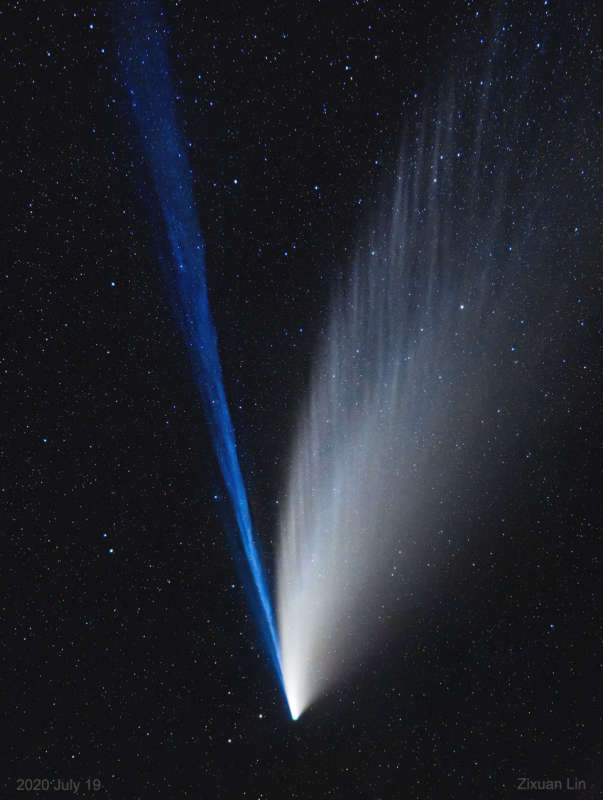Credit & Copyright: Zixuan Lin
(Beijing Normal U.)
Explanation:
What is creating the structure in Comet NEOWISE's tails?
Of the
two
tails evident, the blue ion tail on the left points directly away from the Sun
and is pushed out by the flowing and charged solar wind.
Structure in the
ion tail comes from different rates of expelled blue-glowing
ions from the comet's nucleus, as well as the always complex and continually changing
structure of our
Sun's wind.
Most unusual for
Comet C/2020 F3 (NEOWISE), though, is the wavy structure of its
dust tail.
This dust
tail is pushed out by sunlight,
but curves as heavier
dust particles are better able to resist
this light pressure and continue along a solar orbit.
Comet NEOWISE's impressive dust-tail striations are
not fully understood,
as yet, but likely related to
rotating streams
of sun-reflecting grit liberated by ice melting on its
5-kilometer wide nucleus.
The featured 40-image conglomerate,
digitally
enhanced,
was captured three days ago through the dark skies of the
Gobi Desert in
Inner Mongolia,
China.
Comet NEOWISE will make it
closest pass to the Earth tomorrow as it moves out from the Sun.
The comet, already fading but
still visible to the unaided eye, should fade more rapidly as it recedes from
the Earth.
Notable NEOWISE Images Submitted to APOD: July
21
|| 20
|| 19
|| 18
|| 17
|| 16
|| 15
|| 14
|| 13
|| 12
|| 11
|| 10
& earlier ||
1999 2000 2001 2002 2003 2004 2005 2006 2007 2008 2009 2010 2011 2012 2013 2014 2015 2016 2017 2018 2019 2020 2021 2022 2023 2024 2025 |
Январь Февраль Март Апрель Май Июнь Июль Август Сентябрь Октябрь Ноябрь Декабрь |
NASA Web Site Statements, Warnings, and Disclaimers
NASA Official: Jay Norris. Specific rights apply.
A service of: LHEA at NASA / GSFC
& Michigan Tech. U.
|
Публикации с ключевыми словами:
comet - кометы
Публикации со словами: comet - кометы | |
См. также:
Все публикации на ту же тему >> | |
